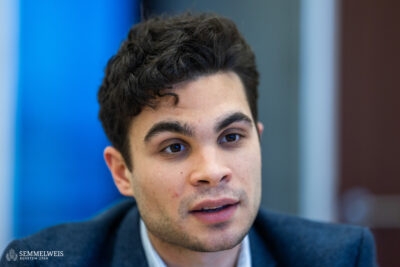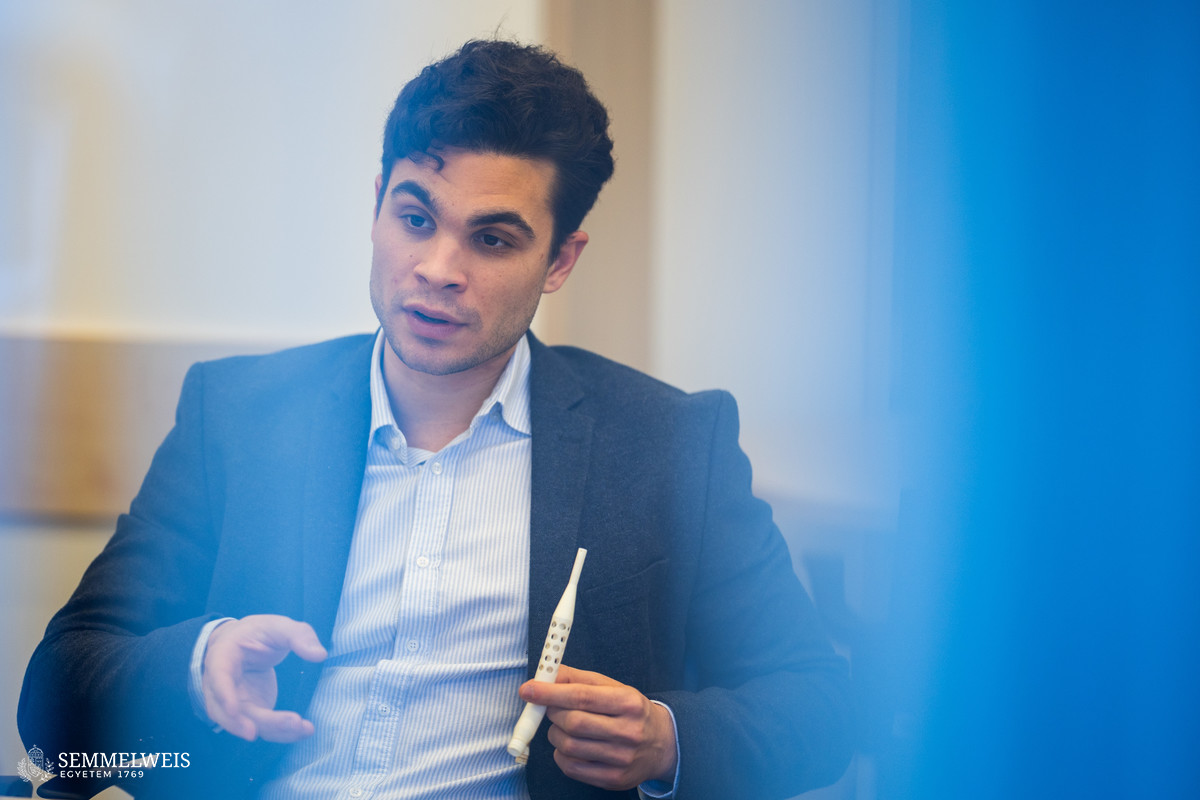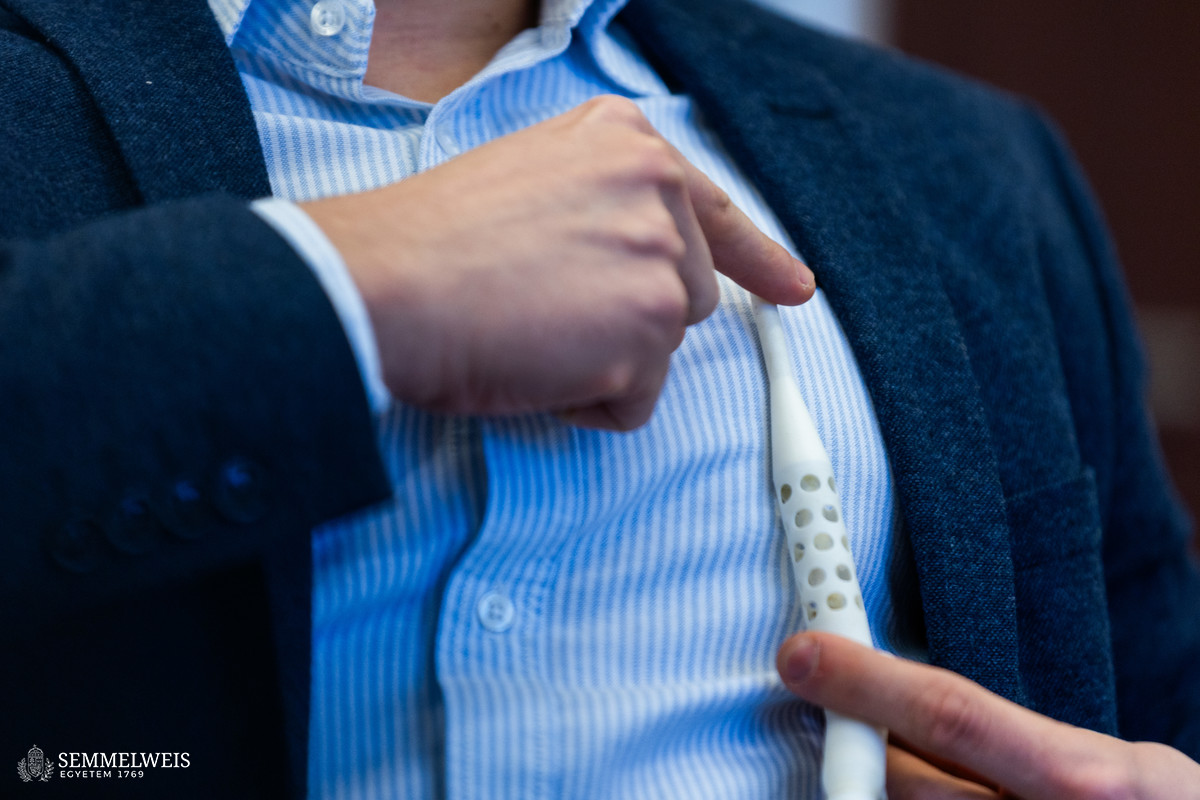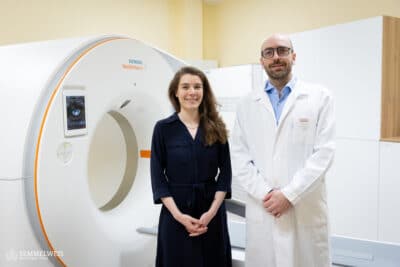It takes a long time to get from a TDK research topic idea to clinical utility, but it is not impossible. Some have already gotten halfway: Dr. Marcell Székely, a PhD student at Semmelweis University and a cardiac surgery resident, started his research before graduation. In 2023, he received the Semmelweis Innovation Award in the TDK category for his prototype transapical, minimal invasive dual-lumen cannula implantable with a left ventricular puncture, developed over four years of research under the mentorship of leading cardiologists at the Városmajor Heart and Vascular Center. The dual-lumen cannula is a specially designed tube that can be implanted in the beating heart via thoracotomy, through the heart’s apex into the left ventricle.
“Based on the novelty of the award-winning device, the university applied for and received a 10-year utility model protection for the territory of Hungary. I am currently working on improving the device and refining the surgical procedure and the perioperative management protocol. The goal is to eventually obtain patent protection. Also, if a company sees the potential in the product and it reaches clinical use, it could be implemented for the first time here at Semmelweis University as a life-saving solution,” said Dr. Marcell Székely.
Every year, Semmelweis University presents the Semmelweis Innovation Award in recognition of the research, development, and innovation activities of researchers, PhD, and TDK students who have developed new scientific research results and innovative solutions during their research affiliated with the university. The award comes with a cash prize and is announced annually in three categories.
His original idea was to find a minimally invasive and rapidly implantable device that could temporarily save the lives of patients with isolated left-sided heart failure in the event of circulatory collapse, i.e. cardiogenic shock until a long-term solution was found. After reviewing the existing therapeutic options currently available for such cases, the idea was to design a device that could be delivered through the heart’s apex via a single incision, with a large part of the device located in the left ventricle and a smaller part in the aorta, and which would supply the heart, coronary artery, and systemic circulation with oxygenated blood, given good lung function.
 As it is an external, extracorporeal pump connected to the cannula, an antegrade (forward direction) blood flow can be ensured with a more easily controllable pumping system. It would undoubtedly require considerable cardiac surgery experience in clinical settings to attach the device to the beating heart apex, but it would also mean less risk of complications for the patient – certainly compared to open-heart surgery.
As it is an external, extracorporeal pump connected to the cannula, an antegrade (forward direction) blood flow can be ensured with a more easily controllable pumping system. It would undoubtedly require considerable cardiac surgery experience in clinical settings to attach the device to the beating heart apex, but it would also mean less risk of complications for the patient – certainly compared to open-heart surgery.
In the initial phase of the research, he measured dissected hearts to determine the design, size, and physiological performance of the cannula to be engineered.
The research gained momentum when he and his supervisor, Dr. Tamás Ruttkay, Assistant Professor at the Department of Anatomy, Histology and Embryology, switched to measuring CT scans of the patient population concerned, and the research continued at the Városmajor Heart and Vascular Center, with the involvement of Dr. Professor Béla Merkely and Associate Professor Dr. István Hartyánszky as supervisors, as well as Dr. Tamás Radovits, Professor at the Department of Cardiology and Head of the Department of Experimental Cardiology and Surgical Techniques, the latter of whom provided guidance for successful large animal model experiments, recalled Dr. Marcell Székely.
During the research, the models were created using a 3D printer, but this would be slow in a clinical setting. Therefore, if a company were to license and mass-produce the device, either by paying a licensing fee or by buying the model protection, it would presumably use the scaling developed by Dr. Marcell Székely, making several ready-made devices available to doctors for life-saving interventions.
The research, on which he delivered a TDK presentation as well, was completed in February 2023. Since then, results have been published, Dr. Marcell Székely obtained his degree, started his residency training, and presented his results at the international heart failure symposium entitled “Brano” International Symposium for Innovations and New Treatment Strategies in Heart Failure, organized in part by Semmelweis University. Following the latter, corporate interest has been shown for possible future use, and cooperation is being developed, as he pointed out.
According to the Hungarian Society of Cardiology, around 200,000 people in Hungary are affected by heart failure, with a prevalence of over 10 percent in the over-70s. In the case of cardiogenic shock, depending on the condition of the patient with isolated left-sided heart failure, doctors attempt various solutions: First, they usually try to stabilize the circulation with medication, and if this fails, they switch to temporary circulatory support devices, either inserted percutaneously or implanted surgically. One of these is called VA ECMO (veno-arterial extracorporeal membrane oxygenation), connected to the heart via two cannulas through the femoral artery and femoral vein, and delivers oxygenated blood to the heart in a process called retrograde perfusion, effectively mimicking the function of the lungs.
However, as the left side of the heart still functions to some extent and continues to pump less oxygenated blood despite the loss of function, this mixes with the blood delivered by the VA ECMO. As a result, the so-called front at the interface between the two is constantly moving around the organ and is difficult to manage properly. On the negative side, the procedure is difficult to monitor; and the retrograde perfusion dilates the left ventricle, hindering its regeneration, which is a significant complication of this method. There is another device with an in-body motor, called Impella, which was also developed to address this problem, but it is not yet available in Hungary. Temporary circulatory support devices that can be implanted by other cardiac surgical methods also usually require two cannulas to be inserted into the heart, either through two small incisions or by opening the chest.
Read the first part of our series on the 2023 Semmelweis Innovation Award winners here.
Melinda Katalin Kiss
Translation: Judit Szabados-Dőtsch
Photos by Bálint Barta – Semmelweis University




